Embarking on Madison’s self-guided tour is like uncovering the city’s remarkable history and vibrant cultural identity. From the iconic Wisconsin State Capitol to the architectural wonder of Monona Terrace, this immersive experience transports visitors through Native American heritage, the Civil War’s legacy, and the powerful student activism of the 1960s. Explore the significance of the pink flamingo and uncover the heart and soul of this captivating Midwestern city. With flexibility to explore at your own pace, this tour promises an unforgettable journey that’ll leave you eager to discover more about Madison’s rich tapestry of stories.
Key Points
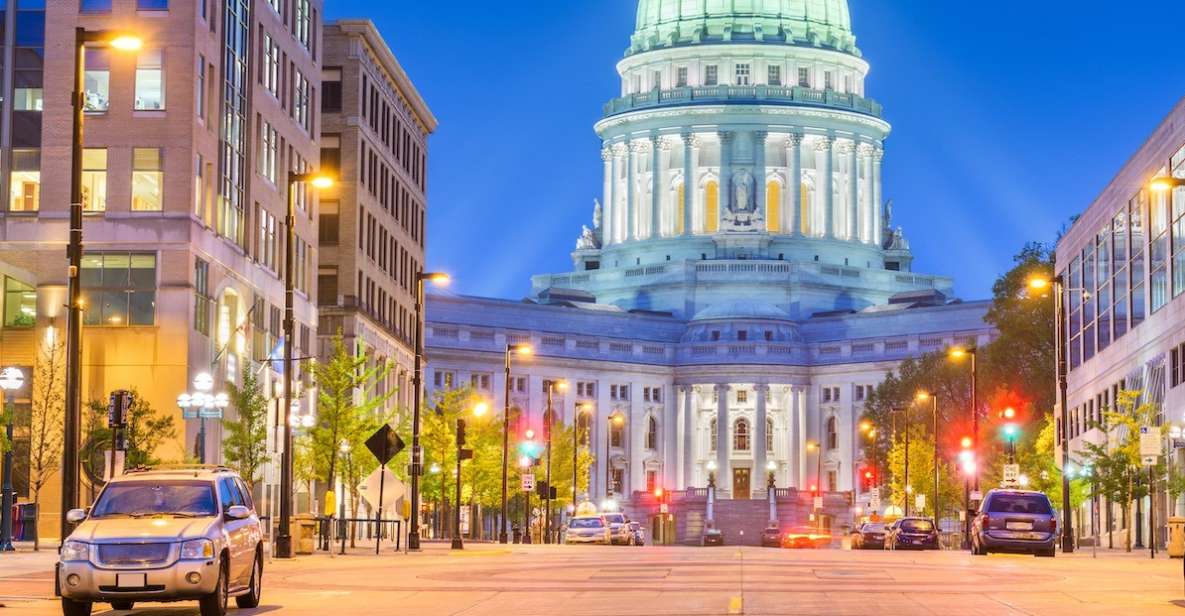
- The self-guided tour starts at the Monona Terrace and winds through the Wisconsin State Capitol, University of Wisconsin-Madison campus, and concludes at the Memorial Union Terrace.
- The tour offers an immersive experience showcasing Madison’s Native American history, Civil War legacy, and rich cultural identity, guided by an award-winning writer.
- Highlights include the iconic Wisconsin State Capitol, the Dane County Farmers Market, Camp Randall’s history, and Frank Lloyd Wright’s Monona Terrace.
- The tour explores the Wakandjaga people’s history, the role of Camp Randall in the Civil War, and the 1960s student protests that shaped Madison’s development.
- The tour’s architectural and literary legacy includes the Memorial Union Terrace, the majestic State Capitol, and the University of Wisconsin-Madison’s renowned authors.
About the Tour
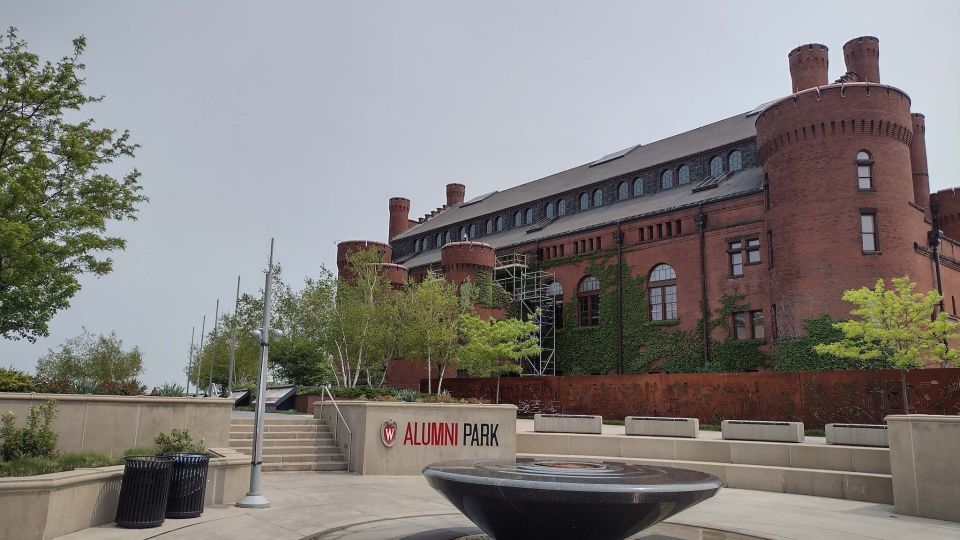
The self-guided Madison Tour allows visitors to explore the city’s historical past and development through GPS playback in the VoiceMap app. The tour takes about an hour to complete, with an audio guide providing insights along the way.
Explore the glory of the Wisconsin State Capitol, hear from award-winning writer Frank Bures, and enjoy the flexibility to linger at stops or complete the tour in an hour. With unlimited use before and after the booking date, this tour offers a truly immersive experience, showcasing the city’s Native American history, Civil War legacy, and rich cultural identity.
Whether you’re a first-time visitor or a local, the Madison Tour is a must-do activity to uncover the heart and soul of this vibrant city.
Tour Highlights
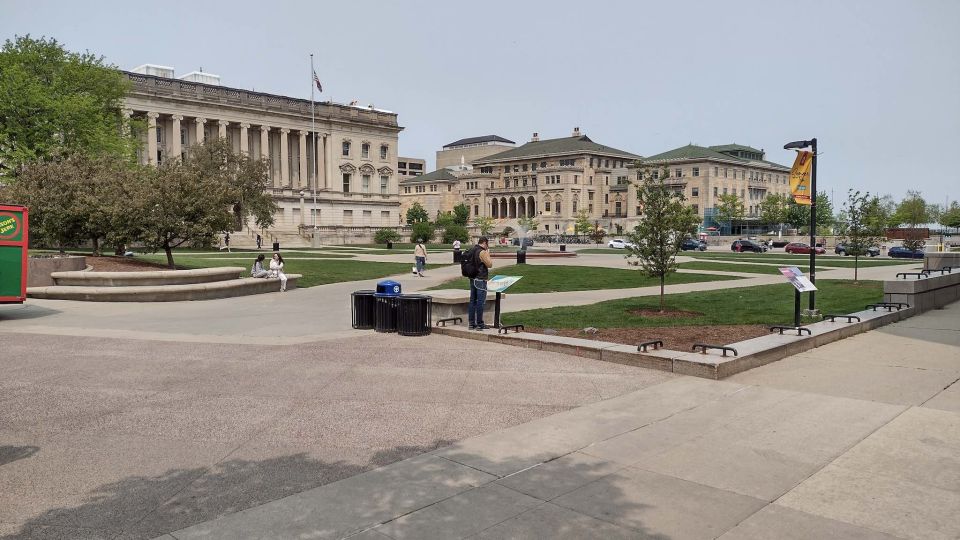
Visitors consistently marvel at the glory of the Wisconsin State Capitol and surrounding landmarks, which serve as the centerpiece of the tour. They’ll also hear insightful commentary from award-winning writer and essayist, Frank Bures, as they explore the city’s rich history and cultural identity.
The flexible tour structure allows guests to linger at stops or complete the full experience in around an hour, ensuring an immersive yet convenient outing.
Tour highlights include:
-
Learning about the Native American Wakandjaga people and the city’s storied past.
-
Delving into Camp Randall’s history as a Civil War training camp and the site of 1960s student protests.
-
Discovering the iconic plastic pink flamingo and its significance to Madison’s identity.
-
Marveling at Frank Lloyd Wright’s architectural masterpiece, Monona Terrace.
Tour Route
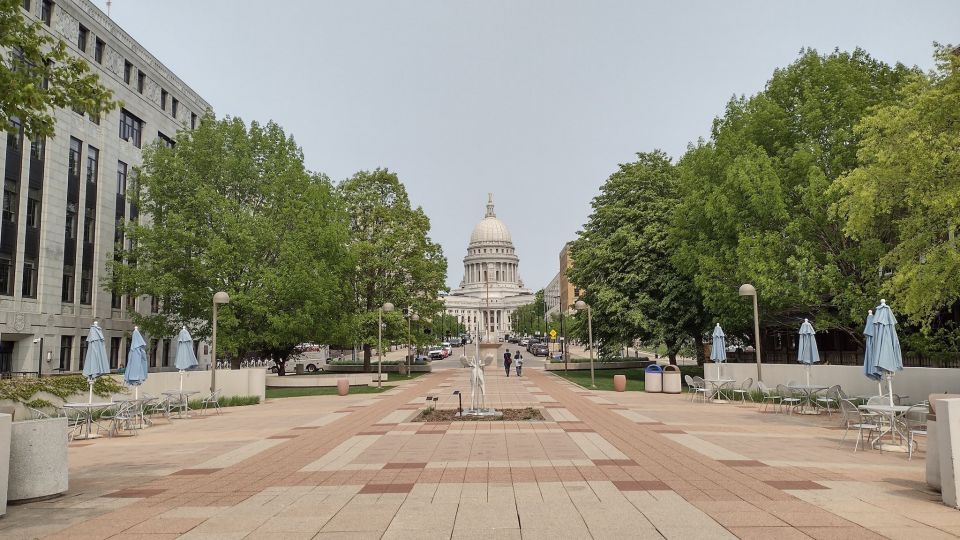
Commencing at the striking Monona Terrace, which offers breathtaking views of Lake Monona, the tour guides participants on a captivating journey through the heart of Madison.
From this scenic starting point, the route winds its way around the majestic Wisconsin State Capitol and the lively Dane County Farmers Market, where the aroma of fresh local produce and the lively chatter of vendors create a vibrant atmosphere.
The tour then leads visitors down the bustling State Street, a thriving hub of activity, before cutting through the iconic University of Wisconsin-Madison campus.
The final destination is the picturesque Memorial Union Terrace, which overlooks the serene Lake Mendota, providing a picturesque conclusion to the tour’s engaging exploration of Madison’s landmarks.
Key Topics Covered
Delving into the city’s rich history, the tour explores the Native American heritage of the Wakandjaga people, who once called this land home.
Visitors will also discover the city’s Civil War legacy, as they learn about Camp Randall’s history as a training camp.
The tour doesn’t shy away from Madison’s turbulent past, recounting the powerful 1960s student protests and the legendary Mifflin Street Block Party.
Interestingly, the iconic plastic pink flamingo and its cultural significance are also highlighted.
Throughout the tour, the guide introduces Madison’s literary legacy, as well as its architectural gems, including the renowned Frank Lloyd Wright masterpiece.
Key topics covered in the tour include:
- Native American history and the Wakandjaga people
- Civil War and Camp Randall’s history as a training camp
- 1960s student protests and the Mifflin Street Block Party
- The iconic plastic pink flamingo and its significance
Native American History
The tour unveils the rich heritage of the Wakandjaga people, the Native American inhabitants who once called this land home, shedding light on their deep connection to the region’s natural landscapes and cultural traditions. Enjoy the stories of their enduring presence, from the significance of Lake Monona to the traditions of their tribal gatherings. Discover how the Wakandjaga navigated and thrived in this picturesque setting, leaving an indelible mark on the land that continues to shape Madison’s identity. Explore the table below to learn more about the Wakandjaga’s history and their lasting influence on the region.
| Wakandjaga History | Cultural Traditions | Natural Landmarks |
|---|---|---|
| Settled in the Madison area for centuries | Intricate weaving and pottery making | Lake Monona and Mendota |
| Relied on hunting, fishing, and gathering | Seasonal gatherings for ceremonies | Effigy mounds and sacred sites |
| Faced displacement and disruption due to European settlement | Oral histories passed down through generations | Diverse flora and fauna |
Civil War and Camp Randall
As the Wakandjaga’s history unfolded, the tour now explores Madison’s role during the American Civil War, centering on the pivotal Camp Randall site. This once-thriving training ground played a vital part in the Union’s war effort, drawing thousands of Wisconsin recruits to its grounds and preparing them for the challenges that lay ahead on distant battlefields.
During the tour, visitors will:
- Learn about the critical role Camp Randall played in mobilizing Wisconsin troops for the Civil War, with over 70,000 soldiers passing through its gates.
- Discover how the camp was transformed into a military prison, holding Confederate prisoners of war.
Explore the site’s evolution, from its use as a training camp to its current status as the home of the University of Wisconsin Badgers football team.
Gain insight into how the Civil War shaped Madison’s development and left an indelible mark on the city’s history.
1960s Student Protests
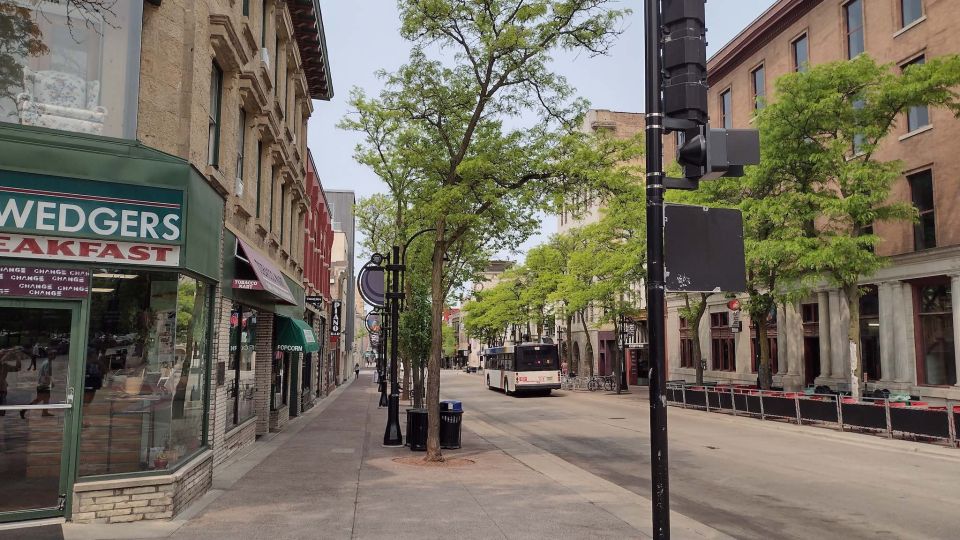
Though the Civil War had long since ended, the 1960s brought a new wave of social upheaval and student activism to Madison’s streets.
Fiery protests erupted on the University of Wisconsin campus, echoing the broader unrest simmering across America. The tour guide’s voice brings these tumultuous times to life, recounting how students, galvanized by the anti-war and civil rights movements, rallied against racial injustice and the Vietnam conflict.
Thousands marched and chanted, their voices amplifying the call for change. One of the most iconic events was the Mifflin Street Block Party, an annual festival that became a hub of counterculture and political dissent.
Through vivid storytelling, the tour invites you to experience the energy and passion that defined this pivotal era in Madison’s history.
Architectural and Literary Legacy
Alongside its rich history of civil rights activism, Madison boasts a remarkable architectural and literary heritage that has long captivated visitors and residents alike. From the striking Monona Terrace designed by the acclaimed Frank Lloyd Wright to the campus of the University of Wisconsin-Madison, which has nurtured generations of celebrated authors, the city’s built environment and creative spirit are inextricably woven into its cultural fabric.
Highlights of Madison’s architectural and literary legacy include:
-
The Monona Terrace, Frank Lloyd Wright’s modernist masterpiece overlooking Lake Monona.
-
The University of Wisconsin-Madison, home to renowned authors such as Aldo Leopold and John Muir.
-
The Wisconsin State Capitol, a majestic example of Greek Revival architecture.
-
The iconic Memorial Union Terrace, a beloved gathering place for students and locals alike.
Frequently Asked Questions
Is the Tour Suitable for People With Disabilities?
The tour appears suitable for people with disabilities, as it is self-guided and allows for flexible pacing. The audio guide can be accessed through a mobile app, providing an accessible experience. However, the tour route may have some accessibility challenges that should be investigated further.
Can I Start the Tour at Any Point Along the Route?
While the tour is designed to follow a set route, visitors can technically start the experience at any point along the way. However, the tour is optimized to begin at the designated starting point for the best flow and context.
Is There a Guided Tour Option Available Besides the Self-Guided One?
No, this tour is only available as a self-guided experience through the VoiceMap app. There’s no option for a live, guided tour. However, the audio guide provides an engaging and informative way to explore the city at your own pace.
Are There Any Food or Drink Options Along the Tour Route?
Along the tour route, visitors can stop at various cafes, restaurants, and food carts to refuel. From tasty local cuisine at the Dane County Farmers Market to lively eateries on State Street, there are plenty of delicious food and drink options to enjoy throughout the self-guided experience.
Can I Purchase the Tour Guide’s Book or Other Merchandise During the Tour?
Unfortunately, the tour does not offer any options to purchase the guide’s books or merchandise during the self-guided experience. However, visitors can explore the city’s many local shops and bookstores to discover the guide’s work and other Madison-themed souvenirs.
Not for you? Here's more of our most recent tour reviews happening neaby
Recap
The Madison tour offers a captivating exploration of the city’s rich history and vibrant culture.
From the iconic State Capitol to the architectural gem of Monona Terrace, visitors will uncover the diverse stories that have shaped Madison’s identity.
Whether delving into Native American heritage, Civil War legacies, or the activism of the 1960s, this self-guided tour provides an immersive and flexible experience to discover the heart and soul of this remarkable city.
